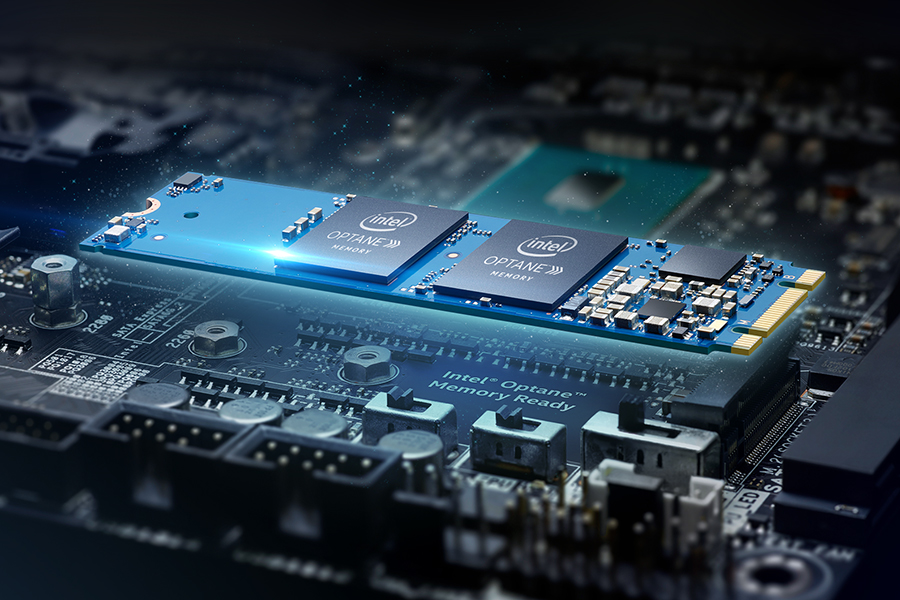High capacity, high performing local storage is expensive. With a typical PC architecture set-up, you have your CPU, your L1, L2, L3 cache and then a DRAM and storage solution, usually a hard drive. The further away from your CPU you operate, the more performance you lose. The pay-off for increasing storage density is that your latency also increases and everything is volatile, so needs to be flushed at reboot, which really slows performance down.
Smart and adaptive
Intel Optane technology, built with 3D XPoint memory media, bridges the gap between DRAM and today’s NAND technologies. It’s a completely new architecture built from the ground up for the data-intensive world: still stackable, that’s the 3D part, but delivering an extremely low latency. It’s non-volatile, so when you reboot a power cycle, everything stays as it is. It’s also smart and adaptive. All the most critical system files are automatically moved over to Intel Optane memory, including system files, boot files and any Microsoft OS critical files. But a new kind of file-aware caching also optimises itself around the user, moving the most used apps and files across so they are easily accessible, while evicting files that aren’t touched. With each subsequent boot, the system will learn more about a user’s behaviour and move across those files and apps that are being regularly accessed: Outlook, Excel, Word. It’s Intel Optane technology innovation that makes all this possible.
By learning and remembering the way you work, Intel Optane memory can accelerate your workflow and increase your productivity. With the new 8th Gen Intel Core processors combined with Intel Optane memory, Intel claims your everyday work tasks will perform up to 2.2x faster meaning you get the high-performance you need to work more efficiently and spend less time in front of your screen.
In terms of speed, 3D-TLC NAND SSDs tend to have a latency of around 100 microseconds. Intel Optane technology with 3D XPoint memory media starts at 6 microseconds: that’s over 16 times faster than any 3D-TLC NAND SSD out there. This really is a ground-breaking new architectural approach. Intel believes there is a big market that wants plenty of high capacity and local storage but also wants SSD-levels of speed and performance at a reasonable cost.
Breaking the storage bottleneck
Data is increasing exponentially with 4k video, gaming and high resolution creative applications. The data files are huge and need to be stored but not to the detriment of slow load and transfer times. Intel’s research has shown that users often prefer to have lots of local capacity. They don’t necessarily have high-speed network connections and would rather keep personal files, such as family photos, physically stored on their own machines.
As CPUs get faster and faster, the challenge has been how to affordably break the storage bottleneck. Intel Optane memory finally ends the cost / performance trade-off that system integrators and customers have long had to make.
Intel Optane memory is perfectly tuned for mass market M.2 desktops. Intel launched with two available SKUs: 16GB and 32GB. Either one is compatible with a standard M.2, one of the most prevalent form factors of mobile and desktop PCs today. Simply install it in any Intel Optane ready system using the Intel® Rapid Storage Technology driver alongside their storage controller and Intel Optane memory will pair up with the hard drive and present to the Microsoft OS as one volume.
For smaller workloads and mainstream uses, the 16GB Intel Optane memory module is the right option. For more intensive gaming or creative, media-intensive applications, the 32GB module is the ideal choice. Intel recently introduced its second generation of Optane Memory products: these are low-capacity M.2 NVMe SSDs with 3D XPoint memory that are intended for use as cache devices to improve performance of systems using hard drives. The new Optane Memory M10 brings a 64GB capacity to the product line. A major new feature for this generation of Optane Memory caching is the addition of the ability to cache a secondary data drive, whereas previously only boot drives were possible. Intel refers to this mode as “data drive acceleration”, compared to the system acceleration (boot drive) that was the only mode supported by the first generation of Optane Memory.
Building systems that accelerate performance without compromising capacity or cost will obviously help to drive PC refresh cycles and generate new upsell opportunities. The fact is that the desktop market continues to massively favour hard drive, so the Intel Optane memory opportunity really is a healthy one for system-builder partners. Pairing with a hard drive manufacturer, makes it easy for small integration shops to add value for these lucrative mainstream users.
Expanding Portfolio
Intel is building a portfolio of Intel Optane technology-based solutions for both desktops, more recently laptops and the data center. Intel Optane SSDs for data centers are available in AIC and U.2 form factors and Intel expect this technology will revolutionize the data center in the way that Intel Optane memory is transforming the desktop. These SSDs help to eliminate data center storage bottlenecks and allow bigger, more affordable data sets. They can accelerate applications, reduce transaction costs for latency-sensitive workloads, and improve overall data center TCO.
Earlier this year, Intel launched the Optane SSD 800P family as the low-end alternative to the flagship Optane SSD 900P. Ideal for use as a standalone SSD, in a dual drive setup or in a multiple SSD RAID configuration (PCH-based or CPU-based), these drives also support lower-power states, allowing them to operate in devices like laptops and 2 in 1 devices, as well as desktop systems.
For further information, talk to your Exertis account manager.
- Up to 2x faster for everyday tasks
- Up to 3.9x faster load speeds
- Up to 3x faster to open large media files
Laptop Performance
- Up to 2.2x faster for everyday tasks
- Up to 4.7x faster load levels
- Up to 1.4x faster to open large media files
*https://www.intel.com/content/www/us/en/architecture-and-technology/optane-memory.html

